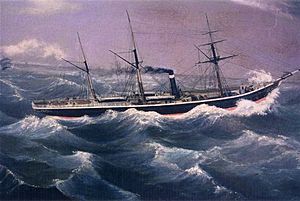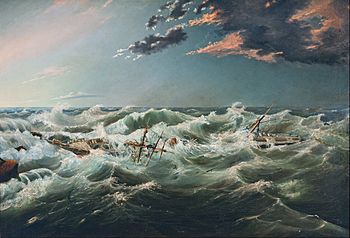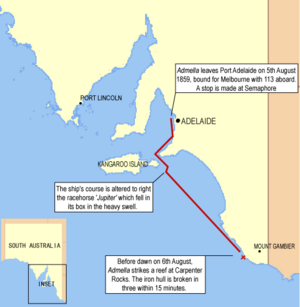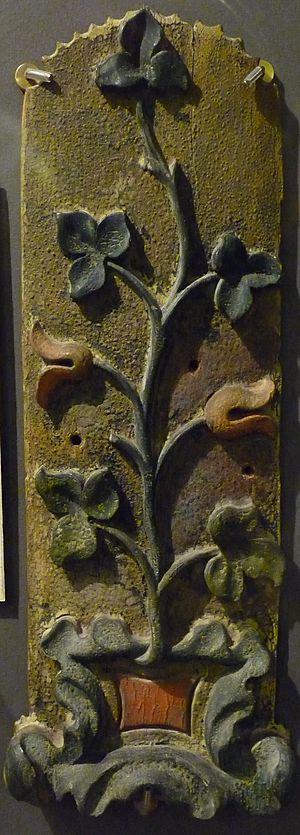SS Admella facts for kids
class="infobox " style="float: right; clear: right; width: 315px; border-spacing: 2px; text-align: left; font-size: 90%;"
| colspan="2" style="text-align: center; font-size: 90%; line-height: 1.5em;" | 
|} The SS Admella was an Australian passenger steamship. It was shipwrecked on a hidden reef near Carpenter Rocks, South Australia. This happened in the early morning of August 6, 1859. Many survivors held onto the broken ship for over a week. They watched as rescue attempts failed, and many sadly died from cold and exposure.
This disaster led to the loss of 89 lives. It is one of the worst sea accidents in Australian history. The Admella wreck caused the greatest loss of life in South Australia's European history. Out of 113 people on board, only 24 survived. This included just one woman, Bridget Ledwith. Fourteen children were among the 89 who died. In August 2009, events were held to mark the 150th anniversary of this sad event.
Contents
- What Was the SS Admella?
- The Final Journey of the Admella
- Heroic Rescue Efforts
- What Happened After the Disaster?
- Admella Relics and Memorials
- See also
What Was the SS Admella?
The SS Admella was named for its route: Adelaide, Melbourne, and Launceston. It was built in 1857 in Port Glasgow, Scotland. This ship was an iron steamer, about 60 meters long and 8 meters wide. It weighed around 395 tons. At the time, it was one of the fastest and most luxurious ships in Australia. It traveled between colonies. Its quickest trip between Adelaide and Melbourne took only 42 hours.
The Admella had made 39 safe trips between Adelaide and Melbourne. There had never been any problems. The ship's only captain, Hugh McEwan, was careful and skilled. The Admella was built with special watertight sections inside. These were meant to be a safety feature. However, they caused the ship to break into three parts very quickly during the disaster.
The Final Journey of the Admella
Captain Hugh McEwan was in command when the Admella left Port Adelaide. This was its last trip on August 5, 1859. It was on its usual route to Melbourne. There were 84 passengers and 29 crew members on board. The ship carried 93 tons of copper, flour, other goods, and four racehorses. One horse fell over because of heavy waves. The ship changed course slightly to help the horse.
At four in the morning, the ship was near the Cape Northumberland light. The captain thought they were far from land. But the ship was actually very close to a dangerous reef. It was likely pushed off course by a strong ocean current.
Suddenly, the ship hit the reef. It tilted over and lay sideways in the rough seas. They tried to lower the lifeboats. But two were destroyed, and one floated away. The waves pushed the ship further onto the reef. It ended up on top of the ridge. Its right side was high out of the water. In less than 15 minutes, the Admella broke into three pieces. Several passengers were washed into the sea. Some rockets were found and fired. They hoped to get attention from the lighthouse at Cape Northumberland, about 25 kilometers away. But the rockets were wet and did not work well. Those on the wreck then looked out to sea for help.
Daylight showed a deserted coast about 1 kilometer away. The shore was covered in crashing waves. People on the wreck started planning to reach the shore. Then, a steamer was seen in the distance. Signals were quickly put up on the remaining mast. The ship's bell was rung. But the other ship, Admella's sister ship Havilah, passed by without seeing them. On the second day, the sea was calmer. Two sailors, John Leach and Robert Knapman, managed to reach the shore using a raft. They were very tired. They hurried through the night to warn the Cape Northumberland lighthouse.
Heroic Rescue Efforts
The wrecked Admella, painted by James Shaw
The lighthouse did not have a telegraph. So, the lighthouse keeper, Ben Germein, rode 16 kilometers to Mount Gambier. From there, he sent a telegraph to authorities in Adelaide, 450 kilometers away. He also sent one to Portland, 100 kilometers east. The ship Corio left from Adelaide, and Ladybird left from Portland. But because of wrong information, both rescue boats had trouble finding the Admella.
Meanwhile, the wreck was hit hard by big waves. Captain McEwan shared the little food they had left. He had to stop survivors from drinking salt water. Drinking it had already caused some deaths. Others, tired from their terrible experience, simply fell into the sea and died. A lifeboat captain described them as:
more like statues than human beings; their eyes fixed, their lips black, for want of water, and their limbs bleached white and swollen through exposure to the relentless surf.
Hurtle Fisher, a passenger, later shared his memories:
- The ship broke into three parts when it hit. Two parts sank right away. The part Mr. Fisher was on got stuck on the rock. Those who were strong enough stayed there for eight days. They had almost nothing to eat or drink. Sitting on the side of the ship, they could see sharks all around them. There was no way to jump off and try to swim to shore. One passenger, sitting next to Mr. Fisher, tried to end his suffering. Mr. Fisher said, "he jumped in just underneath where I was sitting, and the sharks tore him to pieces at once." When Mr. Fisher got on the Admella, he weighed 9 stone 7 pounds. When he was rescued, he weighed 5 stone 12 pounds. One of the horses, named The Barber, swam to shore. He later ran in a race. He had been tied up in a box. Mr. Fisher could not imagine how he got free.
Over the next few days, Corio and Ladybird tried several times to rescue people. Rockets were fired to try to get ropes to the wreck. But huge waves and bad winter storms pushed the rescuers back. Lives were lost as lifeboats were swamped. Another try was made to launch one of Admella's own lifeboats, which had washed ashore. But it also failed. By Saturday, a full week after the wreck, Admellas lifeboat, led by Ben Germein, and Corios boat were launched from the beach. They managed to get through the waves and reach the wreck. Finally, three people got onto one boat. But it then flipped over, and one man drowned.
The Portland lifeboat had been pulled to the scene by Ladybird. It had tried earlier to reach the wreck but was pushed back by the rough seas. Now, it finally succeeded in getting next to the wreck. The remaining 19 survivors jumped and fell into the boat. They were taken to Ladybird, which returned to Portland. This lifeboat is now kept in the Portland Maritime Museum.
What Happened After the Disaster?
The final journey of Admella. (Click to enlarge)
News of the disaster spread quickly in Adelaide and Melbourne. Everyone wanted to know what happened. Telegraph offices were crowded. Newspapers printed extra editions, which sold out right away. In Adelaide, hundreds of people went to the telegraph office to hear the story. Businesses closed, and Parliament stopped its meetings.
For a few weeks, the crews who helped with the rescue were seen as heroes. Especially Captain Greig and the crew of Ladybird. People and businesses raised money for the Admella Shipwreck Reward and Relief Fund. This money was for rescuers and survivors. After an investigation into the wreck, it was decided that a current pushed the ship off course. They also looked into whether magnetic problems in the area affected the compasses on iron ships. The investigation found that the way the watertight sections were built also played a part. The holes for hundreds of rivets had made the metal weaker. The investigation also led to a telegraph being installed at Cape Northumberland.
The SS Admella disaster was a key reason why the Cape Jaffa Lighthouse was built.
Almost a century later, a much larger ship also named Corio was wrecked on the same reef. But everyone on board was rescued that time.
The Admella's wreck site is protected by law. It is located at 37°52′48″S 140°21′00″E / 37.88000°S 140.35000°E. Before it was protected, some items were taken from the wreck over the years. But because of its exposed location, diving there is hard unless the sea is very calm.
In the area between the Victorian border and the Murray River mouth, 101 ships have been wrecked. A total of 218 lives have been lost there.
Admella Relics and Memorials
Ornate wood from ADMELLA shipwreck, 1859
You can see parts of the Admella wreck and learn about the rescue efforts in several places:
- The Port MacDonnell & District Maritime Museum has a display. It includes a small bronze cannon, the ship's bell, and a carving set from the Admella.
- The Portland Maritime Museum has a special Admella display. It includes the Portland lifeboat that saved many survivors.
- At the Cape Banks lighthouse near Carpenter Rocks, there is a memorial for the Admella and those who died.
- The South Australian Art Gallery has two paintings of the wreck by Charles Hill.
- "From the Wreck" is a poem by Adam Lindsay Gordon. It tells the story of Peter Black's ride to Mount Gambier to get help after the Admella wreck.
- In Port MacDonnell, there is a house partly built using wood from the Admella's wreck.
- The copper the Admella was carrying came from Kapunda's copper mines in South Australia.
- The Kapunda Museum has a copper bar salvaged from the Admella wreck.
See also
- List of disasters in Australia by death toll
- List of shipwrecks of Australia
- Timeline of Australian history
- Geltwood (a nearby wreck from 1876)
- James Hurtle Fisher whose two sons were passengers - one died and the other survived.
| History | |
|---|---|
| Name | SS Admella |
| Owner | Robert Little and 7 others |
| Route | Adelaide–Melbourne–Launceston |
| Builder |
|
| Cost | £15,000 |
| Launched | 17 September 1857 |
| In service | March 1858 |
| Fate | Wrecked off Carpenter Rocks, South Australia on 6 August 1859 |
| Status | historic shipwreck |
| General characteristics | |
| Class and type | Steamship |
| Tonnage | 395 GRT |
| Length | 60 m (200 ft) |
| Beam | 8 m (26 ft) |
| Depth | 4.2 m (14 ft) |
| Installed power | twin 100 hp (75 kW) steam engines |
| Propulsion | Steamer Screw |
| Sail plan | Three sails |
| Speed | 17 knots (31 km/h) |
| Capacity | 113 |
| Crew | 29 |




